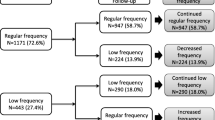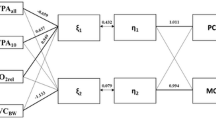Abstract
Purpose
This study examined relationships between health-related quality of life (HRQOL) and objective assessments of habitual physical activity in older adults, focusing on interactions between the amount and intensity of activity.
Methods
Subjects were healthy Japanese aged 65–85 years (74 men and 109 women). Pedometer/accelerometers measured their step counts and the intensity of physical activity in metabolic equivalents (METs) continuously 24 h per day for 1 year. Each individual’s final HRQOL was assessed using the Medical Outcomes Study 36-Item Short-Form Health Survey (SF-36) instrument.
Results
The daily step count and the daily duration of physical activity at an intensity >3 METs were quite closely correlated (quadratic r 2 = 0.93, P < 0.05). After controlling for age, sex, and daily step count, the overall SF-36 score and four constituent dimensions (physical functioning, freedom from pain, vitality, and mental health) were all significantly higher in individuals spending >25% of their total activity at an intensity >3 METs. However, engagement in activity >3 METs was not significantly associated with the remaining SF-36 components (physical limitations, general health, social functioning, and emotional limitations).
Conclusions
Associations between moderate-intensity physical activity and HRQOL in older adults merit further evaluation by prospective studies and/or randomized controlled trials.

Similar content being viewed by others
Abbreviations
- ANCOVA:
-
Analysis of covariance
- BP:
-
Bodily pain
- C1-C4:
-
First through fourth categories of physical activity
- GH:
-
General health
- HRQOL:
-
Health-related quality of life
- METs:
-
Metabolic equivalents
- MH:
-
Mental health
- PF:
-
Physical functioning
- RE:
-
Role limitations due to problems of emotional health
- RP:
-
Role limitations due to problems of physical health
- SD:
-
Standard deviation
- SF:
-
Social functioning
- SF-36:
-
Medical Outcomes Study 36-Item Short-Form Health Survey
- VT:
-
Vitality
References
American College of Sports Medicine. (1998). American College of Sports Medicine position stand. Exercise and physical activity for older adults. Medicine and Science in Sports and Exercise, 30(6), 992–1008.
Nelson, M. E., Rejeski, W. J., Blair, S. N., Duncan, P. W., Judge, J. O., King, A. C., et al. (2007). Physical activity and public health in older adults: Recommendation from the American College of Sports Medicine and the American Heart Association. Medicine and Science in Sports and Exercise, 39(8), 1435–1445. doi:10.1249/mss.0b013e3180616aa2.
Shephard, R. J. (1997). Aging, Physical Activity, and Health. Champaign, IL: Human Kinetics.
Blair, S. N., & Haskell, W. L. (2006). Objectively measured physical activity and mortality in older adults. The Journal of the American Medical Association, 296(2), 216–218. doi:10.1001/jama.296.2.216.
Lee, C., & Russell, A. (2003). Effects of physical activity on emotional well-being among older Australian women: Cross-sectional and longitudinal analyses. Journal of Psychosomatic Research, 54(2), 155–160. doi:10.1016/S0022-3999(02)00414-2.
Washburn, R. A., McAuley, E., Katula, J., Mihalko, S. L., & Boileau, R. A. (1999). The physical activity scale for the elderly (PASE): Evidence for validity. Journal of Clinical Epidemiology, 52(7), 643–651. doi:10.1016/S0895-4356(99)00049-9.
Aoyagi, Y., & Shephard, R. J. (2009). Steps per day: The road to senior health? Sports Medicine, 39(6), 423–438. doi:10.2165/00007256-200939060-00001.
Togo, F., Watanabe, E., Park, H., Shephard, R. J., & Aoyagi, Y. (2005). Meteorology and the physical activity of the elderly: The Nakanojo Study. International Journal of Biometeorology, 50(2), 83–89. doi:10.1007/s00484-005-0277-z.
Togo, F., Watanabe, E., Park, H., Yasunaga, A., Park, S., Shephard, R. J., et al. (2008). How many days of pedometer use predict the annual activity of the elderly reliably? Medicine and Science in Sports and Exercise, 40(6), 1058–1064. doi:10.1249/MSS.0b013e318167469a.
Yasunaga, A., Togo, F., Watanabe, E., Park, H., Park, S., Shephard, R. J., et al. (2008). Sex, age, season, and habitual physical activity of older Japanese: The Nakanojo Study. Journal of Aging and Physical Activity, 16(1), 3–13.
Yasunaga, A., Park, H., Watanabe, E., Togo, F., Park, S., Shephard, R. J., et al. (2007). Development and evaluation of the physical activity questionnaire for elderly Japanese: The Nakanojo Study. Journal of Aging and Physical Activity, 15(4), 398–411.
Stewart, A. L., Mills, K. M., King, A. C., Haskell, W. L., Gillis, D., & Ritter, P. L. (2001). CHAMPS physical activity questionnaire for older adults: Outcomes for interventions. Medicine and Science in Sports and Exercise, 33(7), 1126–1141.
Aoyagi, Y., Park, H., Watanabe, E., Park, S., & Shephard, R. J. (2009). Habitual physical activity and physical fitness in older Japanese adults: The Nakanojo Study. Gerontology, 55(5), 523–531. doi:10.1159/000236326.
Park, H., Togo, F., Watanabe, E., Yasunaga, A., Park, S., Shephard, R. J., et al. (2007). Relationship of bone health to yearlong physical activity in older Japanese adults: Cross-sectional data from the Nakanojo Study. Osteoporosis International, 18(3), 285–293. doi:10.1007/s00198-006-0237-4.
Park, S., Park, H., Togo, F., Watanabe, E., Yasunaga, A., Yoshiuchi, K., et al. (2008). Year-long physical activity and metabolic syndrome in older Japanese adults: Cross-sectional data from the Nakanojo Study. The Journals of Gerontology. Series A, Biological Sciences and Medical Sciences, 63(10), 1119–1123.
Yasunaga, A., Togo, F., Watanabe, E., Park, H., Shephard, R. J., & Aoyagi, Y. (2006). Yearlong physical activity and health-related quality of life in older Japanese adults: The Nakanojo Study. Journal of Aging and Physical Activity, 14(3), 288–301.
Yoshiuchi, K., Nakahara, R., Kumano, H., Kuboki, T., Togo, F., Watanabe, E., et al. (2006). Yearlong physical activity and depressive symptoms in older Japanese adults: Cross-sectional data from the Nakanojo Study. The American Journal of Geriatric Psychiatry, 14(7), 621–624.
Aoyagi, Y., Togo, F., Matsuki, S., Kumazaki, Y., Inoue, S., Takamiya, T., et al. (2004). Walking velocity measured over 5 m as a basis of exercise prescription for the elderly: Preliminary data from the Nakanojo Study. European Journal of Applied Physiology, 93(1–2), 217–223. doi:10.1007/s00421-004-1202-6.
Shephard, R. J. (2009). Maximal oxygen intake and independence in old age. British Journal of Sports Medicine, 43(5), 342–346. doi:10.1136/bjsm.2007.044800.
Callisaya, M. L., Blizzard, L., Schmidt, M. D., McGinley, J. L., & Srikanth, V. K. (2008). Sex modifies the relationship between age and gait: A population-based study of older adults. The Journals of Gerontology. Series A, Biological Sciences and Medical Sciences, 63(2), 165–170.
Tremblay, M. S., Esliger, D. W., Tremblay, A., & Colley, R. (2007). Incidental movement, lifestyle-embedded activity and sleep: New frontiers in physical activity assessment. Applied Physiology, Nutrition, and Metabolism, 32(Suppl. 2)/Canadian Journal of Public Health, 98(Suppl. 2), 208–217. doi:10.1139/H07-130.
Fukuhara, S., & Suzukamo, Y. (2004). Manual of SF-36v2 Japanese Version. Kyoto, Japan: Institute for Health Outcomes & Process Evaluation Research.
Ware, J. E., Jr., & Sherbourne, C. D. (1992). The MOS 36-item short-form health survey (SF-36). I. Conceptual framework and item selection. Medical Care, 30(6), 473–483.
Perneger, T. V. (1998). What’s wrong with Bonferroni adjustments. British Medical Journal, 316(7139), 1236–1238.
Rothman, K. J. (1990). No adjustments are needed for multiple comparisons. Epidemiology, 1(1), 43–46.
Aickin, M. (1999). Other method for adjustment of multiple testing exists. British Medical Journal, 318(7176), 127–128.
Acree, L. S., Longfors, J., Fjeldstad, A. S., Fjeldstad, C., Schank, B., Nickel, K. J., et al. (2006). Physical activity is related to quality of life in older adults. Health and Quality of Life Outcomes, 4, 37. doi:10.1186/1477-7525-4-37.
Rejeski, W. J., & Mihalko, S. L. (2001). Physical activity and quality of life in older adults. The Journals of Gerontology. Series A, Biological Sciences and Medical Sciences, 56(Spec. 2), 23–35.
Shephard, R. J. (1996). Habitual physical activity and quality of life. Quest, 48(3), 354–365.
Shibata, A., Oka, K., Nakamura, Y., & Muraoka, I. (2007). Recommended level of physical activity and health-related quality of life among Japanese adults. Health and Quality of Life Outcomes, 5, 64. doi:10.1186/1477-7525-5-64.
Japan Ministry of Health, Labour and Welfare. (2003). The National Nutrition Survey in Japan 2001. Tokyo, Japan: Daiichishuppan.
Acknowledgments
This research was undertaken as part of the longitudinal interdisciplinary study on the habitual physical activity and health of elderly people living in Nakanojo, Gunma, Japan (the Nakanojo Study). The study was supported in part by a grant from the Japan Society for the Promotion of Science. The authors gratefully acknowledge the expert technical assistance of the research and nursing staffs of the Tokyo Metropolitan Institute of Gerontology, The University of Tokyo, and the Nakanojo Public Health Center. We would also like to thank the subjects whose participation made this investigation possible.
Author information
Authors and Affiliations
Corresponding author
Rights and permissions
About this article
Cite this article
Aoyagi, Y., Park, H., Park, S. et al. Habitual physical activity and health-related quality of life in older adults: interactions between the amount and intensity of activity (the Nakanojo Study). Qual Life Res 19, 333–338 (2010). https://doi.org/10.1007/s11136-010-9588-6
Accepted:
Published:
Issue Date:
DOI: https://doi.org/10.1007/s11136-010-9588-6




